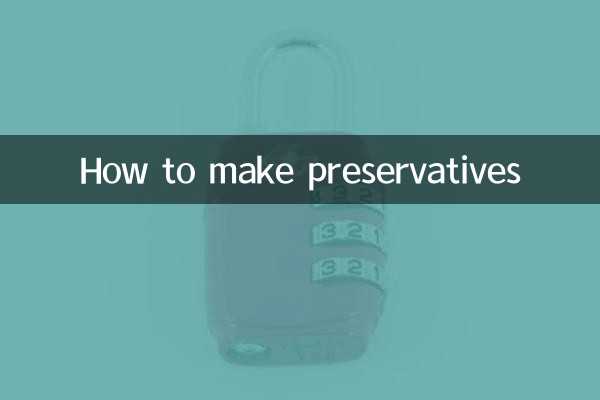How to make preservatives by homemade: Popular topics and practical guides on the entire network in the past 10 days
In recent years, with the popularity of healthy lifestyles, more and more people have begun to pay attention to natural alternatives to food preservation and preservatives. This article will combine popular topics across the network for nearly 10 days to provide you with a detailed guide to homemade preservatives to help you safely and effectively extend the shelf life of food.
1. Inventory of popular anti-corrosion related topics in the past 10 days

| Ranking | topic | Popularity index | Main Platforms |
|---|---|---|---|
| 1 | Natural preservative DIY method | 952,000 | TikTok, Xiaohongshu |
| 2 | Food additive safety dispute | 876,000 | Weibo, Zhihu |
| 3 | Home food preservation tips | 763,000 | B station, Kuaishou |
| 4 | Scientific verification of traditional anticorrosion methods | 689,000 | WeChat public account |
2. Comparison of common homemade preservative raw materials and efficacy
| raw material | Applicable food | Principle of anti-corrosion | Effect duration |
|---|---|---|---|
| salt | Meat, vegetables | High osmotic pressure suppresses microorganisms | 1-6 months |
| White sugar | Fruits, jam | Reduce moisture activity | 3-12 months |
| vinegar | Vegetables, seafood | Acid environment sterilization | 2-8 months |
| Alcohol | Medicinal materials, extracts | Direct sterilization effect | 6-24 months |
3. 5 detailed formulas of homemade preservatives
1. Salt preservative liquid
Ingredients: 500g of salt, 1L of water, appropriate amount of spice (optional)
Preparation method: Dissolve the salt in boiling water, add spices after cooling, and soak the ingredients.
2. Sweet and sour preservative liquid
Ingredients: 300ml of white vinegar, 200g of white sugar, 500ml of water
Production method: Mix all the ingredients and boil them, cool them and use them.
3. Alcohol anticorrosion spray
Ingredients: 100ml of 75% medical alcohol, 50ml of pure water, 5 drops of essential oil (optional)
Production method: After mixing, put it in a spray bottle and spray it on the food surface.
4. Vanilla Oil Preservative
Ingredients: 500ml of olive oil, 20g of rosemary, 20g of thyme
Preparation method: Seal herbs and oil and soak them for 2 weeks and then filter them.
5. Beeswax plastic wrap
Materials: 100g beeswax, 30ml jojoba oil, cotton cloth
Production method: After the material is melted, it is applied to cotton cloth and can be reused.
4. Precautions for using homemade preservatives
1.Strict disinfection: All containers need to be disinfected with boiling water or wiped with alcohol
2.Pretreatment of ingredients: The ingredients need to be clean and dry, and blanch them if necessary
3.Storage environment: Store in cool and dry places, some need to be refrigerated
4.Term of use: It is recommended to mark the production date, generally no more than 6 months
5.Safety Testing: Perform a small-scale test before first use
5. Excerpts of expert suggestions and popular comments
According to recent expert interviews and discussions among netizens, the following views are worth paying attention to:
"Although homemade preservatives are natural, their anticorrosion effect is limited and they are not suitable for commercial use" - Professor Zhang of Food Science
"The combination of lemon juice + salt has a significant effect on fruit preservation" - Xiaohongshu user@Healthy Life Home
"The safest is the combination of traditional methods and modern technology" - Zhihu high-sounding answer
Through the above system introduction, I believe you have mastered the basic methods of making homemade preservatives. It is recommended to choose appropriate formulas based on specific ingredients and preservation needs, and pay attention to the status of the food during use to ensure safety and hygiene. Welcome to share your user experience and improved formulas!

check the details

check the details